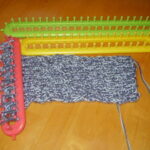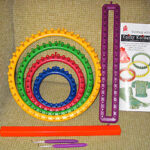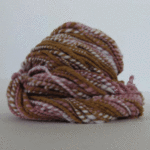The pegs on round, s-shaped, and other knitting looms are usually made of plastic, nylon or hardwood, but other materials are also used. Here we examine all materials and their advantages and disadvantages for making knitting loom pegs.
Plastic pegs are most often seen on Provo Craft’s Knifty Knitter looms. They are generally sturdy, unless you wrap the yarn around them very tightly. If that happens, these pegs do break and can only be replaced by the manufacturer. But if you keep this in mind and wrap accordingly, plastic pegs can last for a long time. They have grooves to make lifting stitches easier – just slip your loom pick into the groove and draw the yarn through the stitch on the peg. They also have caps to keep the yarn from slipping off by accident. These can be a life-saver, especially when transporting your knitting or just putting it down with pets, careless adults, or young children nearby.
Flexible plastic pegs, as of this writing, are only found on In the Attic brand knitting looms. These are flexible, as their name suggests, but they become hard to work with if yarn is wrapped too tightly. Unlike plain plastic pegs, however, they don’t break, because they’re molded into the knitting loom base. They, too, offer grooves and caps, and they have glow in the dark options as well.
Nylon pegs are extremely popular. They’re inexpensive to produce, sturdy, and smooth. Yarn rarely catches on these pegs, and they can be lightly sanded if it does. Loom manufacturers who use nylon pegs make sure they are grooved, capped, and routed into the loom base to make them easy to work with. These are some of the best pegs on the knitting loom market so far.
Cotter pins are usually used on fine gauge looms, where pegs are 1/8″ to 1/4″ apart. Their big disadvantage is that, while they are grooved, they’re not capped. They can also be slippery to work with, which means the yarn often slides off inadvertently. Be aware of this if you purchase a loom with cotter pin pegs.
Zinc-coated steel pegs are similar to cotter pins. However, they do have caps, making them much more knitter-friendly. However, they are not grooved. Because they are extremely smooth, however, the loom pick doesn’t really need a groove to follow when lifting stitches. Next to nylon pegs, which can be impractical for smaller gauge looms, zinc-coated pegs come highly recommended.
Hardwood pegs aren’t often used, but some loom manufacturers do choose these. These pegs have the potential to splinter, break, and catch on yarns. If you choose these, be sure they are finished or waxed in some way, using Danish or linseed oil or bees wax. Like other pegs, try to find hardwood pegs with grooves and caps. These features will keep you knitting instead of frogging – ripping out stitches.
It’s good to know what you’re getting into before jumping in and starting a craft. Knowing what to look for in knitting loom pegs can save you some very frustrating knitting experiences, including frogging, splitting yarn, partially fraying stitches, and more horrors that could make your hair curl. Simply ask loom manufacturers what kind of pegs they use if you can’t tell, or if it isn’t listed on their websites, which it usually is. From there you can choose a loom and peg combination that will compliment your work.



